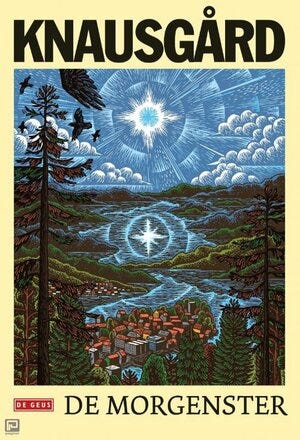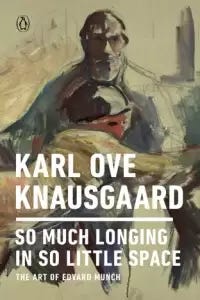Darkness is Growing, Eternity Opens
A review-essay on Karl Ove Knausgaard's The Third Realm
For months now, I have wanted to say something by way of review about The Third Realm, by Karl Ove Knausgaard, as well as the two previous books in his new series, The Morning Star, book one, and The Wolves of Eternity, book two.
Penguin sent me a galley edition of The Third Realm early on, prior to its publication date of October 1st, 2024, but I didn’t finish the book until about a month after this (I was also given a hardcover of it for my birthday, pictured below). I spent a week camping, reading the novel—and listening to a lot of black metal, the leitmotif not only of The Third Realm but the whole Morgenstjernen cycle thus far (from here on, I will use The Morning Star to refer to the first book and the Norwegian title, Morgenstjernen, to refer to the series as a whole).
Usually, when I review a book, my first impulse is copious block-quotation. I like the way these look (Substack’s block quotations are nice, although they would do well to shrink the size of block-quoted type by two points), so I am prone to overuse them. I curb this first impulse by waiting a while after I’ve read the book, and then, further, by not reaching for it while I write.
The ideal book review, which nobody would appreciate in reality, would be similar to what is described in the Borges story, “Pierre Menard, Author of the Quixote,” where Pierre Menard rewrites Don Quixote exactly and in its entirety, on his own and without looking at Cervantes’ original.
Here—maybe in footnotes, so that the “read time” of the Substack piece would still only be a minute long—I would block-quote the entire text of The Morning Star, The Wolves of Eternity and The Third Realm, so that I wouldn’t have to say anything extraneous about them.
To satisfy my desire for block quotation (and avoid reproducing the relevant texts in 1,978 unformatted pages worth of footnotes), I turn to a page written by myself, in my yellow notebook (pictured above), which I’ll reproduce here unchanged (followed by some general remarks on style and theme, rather than plot).
Notebook entry
Knausgaard’s best quality as a novelist is his most unstable (volatile) quality as an essayist. Throughout his books, I get the feeling that the main purpose of much, if not most, of the text is to give
realitya world to his essayistic writing, which is of a different density than its surrounding text.When this works, it is the high point of his writing. When it falters, it can border on the insufferable—but even in such cases, it may work in favor of the character whose mouth or in whose hand he couches the attempt (the literal root of essay is, after all, attempt). I won’t enumerate what I see as the bad attempts, except to say that, in the new Morgenstjern [sic] cycle of novels, there has only been a brief waver in the third book. All other essayistic crystallizations have been wonderful, and these are worth briefly including.
Morning Star [sic] [name, quick description]
Wolves of Eternity
The Third Realm
→ Of which subject [illegible word] is dealt with in a surprisingly convincing and atmospherically powerful way: black metal.
/ [Line drawn down middle to the right of the three first titles] /
(include og covers)
Night Shift [should be Night School]
Arendal
On the subject of cover art, my favorite might be that of the Dutch edition, published by De Geus.
In my notebook entry, I did not end up listing the essayistic incursions embedded in their respective fictional landscapes, but it’s worth reiterating: they are among the best moments of Knausgaard’s prose, specifically the essay at the end of The Morning Star on death and the middle, titular essay in The Wolves of Eternity on Alexander Bogdanov and Soviet experimentation into the extension of human (and non-human) life (Experiments in the Revival of Organisms), the forestalling of the horizon of death and the ethical injunction to resurrect those already dead—in fact, this is the major theme of the book, the eerie possibility of life unending, of eternal living death, as presented in Revelation.
I will return to this dimension of eeriness in another section of this review/essay—it is my single favorite quality of these books and the reason I will read as many of them as get written.
Oscillation between fiction and essay
This relationship between essay and Knausgaard’s signature style of mundane fiction is what originally propelled my interest through all six books of My Struggle, but because there are so many shifts of voice and perspective in Morgenstjernen, the break between essay/fiction is more visible, often to the extent that Knausgaard has his characters write their own tracts, essays and book drafts, which we then read.
In the engrossing univocity of My Struggle, on the other hand, the essayistic writing is smoothly integrated directly into the march of descriptive, occasionally itemizing, prose, to use Frederic Jameson’s word.
As I point out in the notebook entry, these passages in Morgenstjernen are volatile: one can feel Knausgaard oscillating in and out of his own autobiographical voice, drawing near to the character at hand yet always pulled back to himself. When the oscillation of fiction/essay fails or falters, as it does once or twice, the spell is broken. But this doesn’t happen for long, and the reader is able to fall in once again, forgiving not Knausgaard but the character-narrator for their (basically endearing) lapse in composition.
This movement between fiction and essay is smooth and wavelike in My Struggle; in Morgenstjernen, it is abrupt, one might say atomized or particulate.
This ability, whether expressed in the form of a wave or a particle, is why Knausgaard so often gets compared to Proust. But Proust writes more so in the vein of living duration, inner Bergsonian time, as opposed to concrete “clock” time, which Knausgaard patiently walks us through.
Knausgaard, however much he recalls and recollects, is not engaging (almost at all) in this impressionistic aether of time, as in Proust, but in the expressionistic wave-particle chaos of space. It is no coincidence that Knausgaard’s best non-novelistic writing is about painting, the spatial art par excellence, in So Much Longing in So Little Space, his book about Edvard Munch.
And although Proust’s writing on architecture (via the heavy influence of John Ruskin) is sui generis, even the spatial aspect of architecture gets transposed or metamorphosed in his work as a solidified music simultaneously concealing, preserving and delivering (the German word aufhebung is appropriate here) the spirit of time over that of space. The passages on the Vinteuil sonata in Remembrance of Things Past bear witness to Proust’s affinity with durative time, the purest artistic incarnation of which is music.
“Intermittence on Memory”, dealing with Proust, Bergson, Sebald, time and memory, will represent a brief interruption of the present review/essay.
<Next>
"Freezing Moon," track 2, De Mysteriis Dom Sathanas, Deathlike Silence, 1994. The hyperlinked recording is the one worth listening to, though. I’m not a big fan of the album version.







A copy of The Morning Star has been beckoning me for several months from a pile on my shelf, and what you write here intrigues me all the more, very nice. Will have to read the novel soon